
How to Correctly Understand Electromagnetic Flowmeter?
2025-05-13 16:42
Electromagnetic flowmeter is an instrument that measures the flow rate of conductive fluid based on the electromotive force generated when the conductive fluid passes through an external magnetic field. It is mainly composed of a magnetic circuit system, a measuring conduit, electrodes, a housing, a lining and a converter. Electromagnetic flowmeters are suitable for measuring the volume of conductive liquids and slurries in closed pipe flows, such as clean water, sewage, various acid, alkali and salt solutions, slurries, slurries, pulp, syrups and edible liquids.
The principle of electromagnetic flowmeter is based on Faraday's law of electromagnetic induction. When a conductive liquid moves in a magnetic field and cuts magnetic lines of force, an induced electromotive force E perpendicular to the direction of movement and the direction of the magnetic field will be generated at both ends of the conductor. This electromotive force is proportional to the flow rate (V) of the conductive liquid, that is, E=BLV (B is the magnetic induction intensity of the magnetic field, L is the length of the conductor, and V is the speed of cutting magnetic lines of force).
After the converter is powered on, the excitation current drives the coil to form a magnetic field in the measuring tube. When the medium flows along the measuring tube and cuts the magnetic lines of force, the induced electromotive force generated is transmitted to the converter through the two electrodes on the inner wall of the measuring tube. After the converter performs signal processing and calculation, the measured flow value is obtained.
The measured flow data is displayed on the display screen and output in the form of (4~20)mA, pulse or field bus (RS485).
Electromagnetic flowmeter performance
Advantages and Disadvantages
Advantages:
(1) There is no flow blocker (empty pipe) in the measuring pipe, so the pressure loss is small and the volume flow of solid-liquid two-phase medium can be measured;
(2) The measured volume flow is independent of many physical quantities of the measured medium;
It is not affected by changes in the temperature, pressure, density, viscosity, and conductivity of the measured medium, and no correction is required;
(3) The output signal is linearly related to the volume flow of the measured medium, with a wide range ratio and no nonlinear correction required;
(4) The requirements for the straight pipe section before and after the flow measurement tube are low (5D in front and 2D in the back);
(5) Bidirectional measurement, which can measure forward and reverse flow;
(6) High measurement accuracy;
(7) The sensor can be selected as IP68 submersible type.
Disadvantages:
(1) Unable to measure non-conductive liquids (normally <5us/cm);
(2) Unable to measure gas-liquid two-phase or gas and other media;
(3) Affected by the lining, the measured fluid temperature generally does not exceed 180℃;
(4) The cost of large-caliber is relatively high.
AUTO Instruments electromagnetic flowmeter is trustworthy. If you have any needs, please feel free to contact us!
